|
 October 8, 2001 October 8, 2001 |
 It's a great day here in Orem, Utah! I have made it successfully back from our Fun Family Trip to Disneyland and the 3 day ITA Home Inspector conference in Las Vegas. I have to admit that I came back burned out, exhausted and very little desire to inspect properties. It's a great day here in Orem, Utah! I have made it successfully back from our Fun Family Trip to Disneyland and the 3 day ITA Home Inspector conference in Las Vegas. I have to admit that I came back burned out, exhausted and very little desire to inspect properties.
I have now had time to recharge my batteries and we are looking at the return to a full inspection schedule. This will bring a great source of relief to our bank account which has been strained by the trips and general lack of work due to the terrorist bombings. It is very strange how the terrorist activities have changed the real estate sales in our County. The majority of our market dies, while the Salt Lake county to the north of us has reported very little change.
Our market has still seen activity in the starter home range, yet the middle and upper markets have slowed down considerably. This is probably due to the uncertainty of the middle and upper end clientele. The starter home clients just want in a house. War or not, if you give them the keys they will gladly move in. The million dollar house clients also couldn't care less about the on goings of the world because they are operating on a different financial lifestyle. When they find the house they want, they buy it.
The middle and upper end homes are sitting for sale with very few potential buyers coming to see them. I believe that this is due to the uncertainty of finances and poor future of job security. Everybody seems to be staying put, ready to ride the storm out.
|
|
|
 WHAT IS YOUR OUTLOOK? WHAT IS YOUR OUTLOOK? |
| As you look to the final quarter of 2001, what are your predictions? Do you think that the market will taper off, or do you think that your inspection schedule will remain strong? Will the war efforts strengthen the housing market in your areas, or will the terrorist activity that is sure to continue on our soil bring your markets to a halt? I think of the thousands or workers who had been laid off in Las Vegas within days of the September 11 tragedy. This type of shift in the local job market cannot be good for the resale market. I have heard similar rumors of major job layoffs at Boeing up in Washington.
 Where will all of these people go? Can the surrounding businesses absorb all of those that will be laid off? Or will they have to relocate? If they relocate, will there be others willing to buy their vacated homes? This type of activity could stimulate our businesses instead of halting them.I think the thing I fear is long months of potential home buyers holding tight with a wait and see attitude. This would provide bread crumbs on the Leavitt dinner table. My county of operation is just the type of consumer that would prudently hold tight before upgrading during the upcoming turmoil. This is odd because there are currently very low interest rates. The Appraisers are busier than ever to accommodate the large growing refinance market. Where will all of these people go? Can the surrounding businesses absorb all of those that will be laid off? Or will they have to relocate? If they relocate, will there be others willing to buy their vacated homes? This type of activity could stimulate our businesses instead of halting them.I think the thing I fear is long months of potential home buyers holding tight with a wait and see attitude. This would provide bread crumbs on the Leavitt dinner table. My county of operation is just the type of consumer that would prudently hold tight before upgrading during the upcoming turmoil. This is odd because there are currently very low interest rates. The Appraisers are busier than ever to accommodate the large growing refinance market.
So while the Appraisers are feasting on the current market, how do you predict it will affect your local Home Inspector market?
|
|
|
 CPSC AMANA RANGE FOLLOW-UP CPSC AMANA RANGE FOLLOW-UP |
|
Last week's CPSC recall brought a surprising response........
Yes I have seen one of these ranges - actually every time I walk into my kitchen. The funniest part about it is I just ran the self cleaning mode yesterday and my CO Alarm went crazy. During the self cleaning mode you couldn't touch the overall surface on the range due to the extreme temperature. This was the first time since we've owned the range that I ran the self cleaning mode. After talking with my wife she said it always gets like that.
MORAL OF THE STORY - Maybe I should help out with house chores more often so I can find out these things sooner. Thomas Skrodzki - Westfield, MA
|
|
|
 CPSC SEASONAL CO WARNING CPSC SEASONAL CO WARNING |
- NEWS from CPSC
- U.S. Consumer Product Safety Commission
| Office of Information and Public Affairs |
Washington, DC 20207 |
| FOR IMMEDIATE RELEASE |
|
| October 4, 2001 |
Contact: Ken Giles |
| Release # 02-004 |
(301) 504-0580 Ext. 1184 |
|
CPSC Urges Seasonal Furnace Inspection to Prevent CO Poisonings
WASHINGTON, D.C. - As the weather turns colder throughout much of the country, the U.S. Consumer Product Safety Commission (CPSC) urges consumers to have a professional inspection of all fuel-burning appliances - including furnaces, stoves, fireplaces, clothes dryers, water heaters and space heaters - to detect deadly carbon monoxide (CO) leaks.
These appliances burn fuels - typically gas, both natural and liquefied petroleum; kerosene; oil; coal; and wood. Under certain conditions, these appliances can produce deadly CO. However, with proper installation and maintenance, they are safe to use. An annual inspection and service is the first line of defense against this silent killer.
CO is a colorless, odorless gas produced by burning any fuel. The initial symptoms of CO poisoning are similar to flu, and include headache, fatigue, shortness of breath, nausea and dizziness. Exposure to high levels of CO can cause death.
"Each year, CO poisoning associated with using fuel-burning appliances kills about 200 people," said CPSC Chairman Ann Brown. "Having this inspection performed could prevent a terrible tragedy."
CPSC recommends that the yearly professional inspection include checking chimneys, flues and vents for leakage and blockage by debris. Birds, insects and other animals sometimes nest in vents and block exhaust gases, causing the gases to enter the home. Leakage through cracks or holes could cause black stains on the outside of the chimney or flue. These stains and strange smells can mean that pollutants are leaking into the house. In addition, have all vents to furnaces, water heaters, boilers and other fuel-burning appliances checked to make sure they are not loose or disconnected.
Have your appliances inspected for gas leaks and adequate ventilation. A supply of fresh air is important to help carry pollutants up the chimney, stovepipe or flue, and is necessary for the complete combustion of any fuel. Never block ventilation air openings. Also, make sure the appliance is operating on the fuel that it is designed to use. An appliance must be modified by a professional to burn propane.
CPSC recommends that every home should have at least one CO alarm that meets the requirements of the most recent Underwriters Laboratories (UL) 2034 standard or International Approval Services 6-96 standard. CPSC worked with UL to improve the CO alarm standard to improve the reliability of alarms, and reduce the potential for nuisance alarming.
Consumers should also have the vent pipes on their heating systems inspected. In 1998, CPSC worked with the furnace and boiler industry and the manufacturers of high-temperature plastic vent (HTPV) pipes to conduct a vent pipe recall program. The program's purpose is to replace, free of charge, an estimated 250,000 HTPV pipe systems attached to gas or propane furnaces or boilers in consumers' homes. The HTPV pipes could crack or separate at the joints and leak CO. Consumers should call the recall hotline toll-free at (800) 758-3688, between 7 a.m. and 11 p.m. ET, seven days a week, to verify that their appliance venting systems are subject to this program.
CPSC continues to work with the furnace industry to develop new technologies to address the hazards of CO poisoning and fire. Results include a standard that added blocked-vent shut-off devices to protect against blocked vent pipes and chimneys, and requirements to guard against a vent pipe becoming separated from the furnace. Both of these conditions could lead to CO poisonings. Also, all gas-fired furnaces manufactured since 1987 have flame roll-out protection technology that prevents flames from shooting out of the furnace's combustion chamber and starting a fire.
What Carbon Monoxide verbiage do you include in your inspection reports?
|
|
|
 COMPLAINTS - FIGHT OR PAY? COMPLAINTS - FIGHT OR PAY? |
What are your thoughts about fighting the moral battles of a customer's complaint? Do you pick your battles carefully, or take them all head on?
If I made a legitimate mistake, I write the check. No argument. If I believe I have done nothing wrong I am very reluctant to write a check unless it is a small amount of money and the good will is worth the investment. If everybody else involved but the client agrees with me that there is no fault on my side and there is no good will that is likely to translate into future business I will not write the check unless it is a matter of saving a big time investment. Mostly I just say “I am sorry you feel that way“ and that is the end of it. Jon Gudnason - Placerville, CA
|
|
|
 WIRSBO WATER SUPPLY PIPING WIRSBO WATER SUPPLY PIPING |
On another Home Inspector forum this week came a great question about a newer plumbing supply pipe on the market. It is odd to me that it takes years for a new product to permeate the entire North American market. I was seeing this pipe 3 years ago, whereas Joe Kelly just came in contact with it this week. This is not because Joe does not perform a lot of inspections, it just takes time to get products approved by different municipalities. Since some of you have not been exposed to it, I thought I would share with you the question and responses......
I did a townhouse inspection today with clear (opaque) plumbing lines throughout the house? I've never seen this type before. I couldn't find any manufacturer labeling but the blue lettering did say suitable for domestic water supply to 80psi. Tee and valve connections appeared to be some type of threaded compression on brass fittings? Elbows were crimp connectors. The tubing is very flexible and clip on metal radius protectors were visible. Does anyone know of any problems with this type of supply? Anything like Polybutalene? Joe Kelly
Product called "aqua pec". Replacement in some areas for Poly "B". Been in use in Canada for some three years. Paul Tobolski - Banff, Canada
It sounds like PEX, cross linked polyethylene, which has so far been a good product. At least from what I have heard and seen. The product comes in many different colors. I have most collonly seen it as blue and red. These are solid, or opaque, colors. I have also seen a kind of milky white, which might be described as translucent. Opaque meens light will not go through it. Copper and steel are opaque. http://www.plumbingworld.com/pex.html, http://www.vanguardpipe.com/news7.html Jon Gudnason - Placerville, CA
The product you saw was probably a high performance product produced by Wirsbo and is being used very widely now! Have seen it approved in many Calif & Nev jurisdictions....and also saw it being used in Idaho & WA. Bob Guyer
Add Utah and Wyoming to your list. The interesting part is to observe the Wirsbo patented joint fitting. This includes a plastic sleeve the is pressure slipped over the pipe and fitting to form a water tight joint. Talk about job security for the plumbers who use this system..... They have been able to eliminate the homeowner from being able to repair their own systems. Instead, they have to call the Plumber.
The piping is called Aquapex, it is just another PEX piping. The fittings are called ProPEX and they are proprietary. I started seeing these systems about 2.5 years ago in my area and I have never seen any system failures relating to the pipes or the fittings. To see and read about this product, visit http://www.wirsbo.com/Products/Aquapex/aquapex.htm
Michael Leavitt Orem, Utah
|
 PEX FITTINGS PEX FITTINGS
|
|
The August 9, 1999 edition of the Monday Morning Messenger I reported the following...........
While looking at this brand new home I encountered a new fitting that I had yet to encounter previously.
 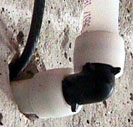 I first noticed them in the interior basement water main shut off. The pipe was clear and the joint fitting looked to be a plastic sleeve that was slid over the top of the connection. The connectors were a combination of plastic and brass. All of the connections looked to be made without any glue joints. I first noticed them in the interior basement water main shut off. The pipe was clear and the joint fitting looked to be a plastic sleeve that was slid over the top of the connection. The connectors were a combination of plastic and brass. All of the connections looked to be made without any glue joints.
The interesting thing was that there was not a typical PEX manifold and at each turn there were fittings. Up until now all of the PEX that I have been encountering were in manifold systems without any in wall splices. Instead, there were large bends and loops in the lines. I had been told that this also helped with the expansions and contraction in the lines. This installation left no major slack areas for expansion and contraction.
 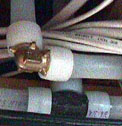 The PEX used in this home was marked with the following..... WIRSBO AQUAPEX™ 3/4 IN SDR9/ sa B137.5 POTABLE/ NSFP-4/ ASTMF876/F877/ ICBO ES ER5142 HAUSER/ SBCCI PST & ESI 9661 / 160PSI 73.4f/ 100 PSI 180f/ 80 PSI 200f WIRSBO-PEX-a TUBING UNI6990209 07356 .... This is quite a bit of information and it is printed over and over on the lines. The tubing was not the normal red and blue. Instead, it was all milky white in color. The PEX used in this home was marked with the following..... WIRSBO AQUAPEX™ 3/4 IN SDR9/ sa B137.5 POTABLE/ NSFP-4/ ASTMF876/F877/ ICBO ES ER5142 HAUSER/ SBCCI PST & ESI 9661 / 160PSI 73.4f/ 100 PSI 180f/ 80 PSI 200f WIRSBO-PEX-a TUBING UNI6990209 07356 .... This is quite a bit of information and it is printed over and over on the lines. The tubing was not the normal red and blue. Instead, it was all milky white in color.
I was going to throw up the question to all of you as to what types of fittings these were and then I blindly stumbled onto the manufacturer's website. The following is their description of the product at www.wirsbo.com.
Wirsbo AQUAPEX® -- The Future of Plumbing
Current problems with corrosive water, leaky fittings and disintegrating pipe have left the plumbing industry looking for a reliable solution. AQUAPEX® is the answer. AQUAPEX® uses AQUAPEX® tubing (Engel), which is cross-linked polyethylene (PEX) tubing for hot and cold potable water service and distribution. Wirsbo PEX tubing has been used in plumbing systems around the world for over 25 years, longer than any other flexible plumbing system available.
AQUAPEX® is a logical choice for modern plumbing systems because it offers many advantages over rigid metal and other plastic tubing.
- Its light, flexible nature makes it installation-friendly reducing labor costs.
- Its non toxic formula makes it completely clean, healthy and safe. Concerns about lead, copper and other toxins leaching into drinking water are eliminated.
- Its smooth, cross-linked structure makes it resistant to corrosion. AQUAPEX® tubing will not corrode, pit or scale.
- A 25 year track record means it is proven effective in plumbing.
- Its unique ProPEX® fitting system is the most reliable system on the market. AQUAPEX® systems even come with a 25 year warranty when they are installed by a Wirsbo trained installer.
The AQUAPEX® system boasts the best fitting system in the industry -- ProPEX®. ProPEX® fittings use the shape-memory of AQUAPEX® tubing. Using the hand-held ProPEX® expander tool, the tubing and a PEX ring are expanded and the fitting is inserted. The tubing then compresses around the fitting as it tries to return to its original shape.
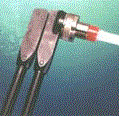 The connection is permanent, leak-proof and proven reliable. Wirsbo also offers an electrically powered automatic ProPEX® expander tool for even faster, easier connections. The connection is permanent, leak-proof and proven reliable. Wirsbo also offers an electrically powered automatic ProPEX® expander tool for even faster, easier connections.
A Home Run: The flexibility of AQUAPEX® tubing allows alternative installation methods that minimize the pressure drops that result when two fixtures operate simultaneously. Using the Home Run method, centrally located manifolds distribute water to each fixture with dedicated hot and cold water lines. The Home Run method requires fewer fittings, helping to eliminate leaks and keeping overall material cost competitive.
Wirsbo's AQUAPEX tubing has the incredible property of thermal memory. If the tubing becomes kinked, heating it up with a heat gun will make it transparent and return it to its original shape and strength. The tubing returns to its natural opaque color when cooled.
AQUAPEX® BENEFITS BUILDERS AND CONSUMER
- Proven Product
- Installed without Joints in the Slab
- Clean and Healthy -- No Lead in AQUAPEX
- 25 Year Warranty
- Looks Professional
- Lower Delivered Cost
- Fewer Joints in the Walls
- Excellent Freeze Resistance
- Corrosion Resistant
AQUAPEX® BENEFITS THE PLUMBERS
- Proven product
- Flexible
- Easy to Install
- Light-weight
- No Flame Necessary
- ProPEX Does not Leak
- Inert to Aggressive Soil and Water
- Excellent Freeze Resistance
- Run in slab, or over head
- Perfect for Retrofit, Remodeling Work
- Provides a Professional Looking Plumbing System
- Plumbers get Trained and Pass on 25 Year Warranty
Code Approvals: AQUAPEX tubing is manufactured and listed to ASTM F876, F877, and F1960 for use in hot and cold potable water distribution systems. It is approved by BOCA, CABO, ICBO 5142, SBCCI, IPC for potable hot and cold water distribution, and by IPC and SBCCI for water service. It has IAPMO Acceptance. AQUAPEX® is approved in many states, cities and counties around the United States and Canada. Check with your local code official for further code information.
AQUAPEX® tubing undergoes the most exhaustive testing of any material on the market. Wirsbo PEX undergoes an extensive battery of tests internally, and through an independent third party testing agency. Wirsbo PEX tubing currently holds the unofficial world record for long-term testing at elevated temperatures and pressures -- 23 years at 203 ° F at 152 psi, and still going. The record will be official when the testing is complete.
AQUAPEX® tubing is rated at 180° F at 100 psi, 200° F at 80 psi and 73.4° F at 160 psi.
Are you encountering PEX in your area?
|
|
|
 PHOTO CHALLENGE #75 FEEDBACK PHOTO CHALLENGE #75 FEEDBACK |
Is this a "Reportable Condition"?
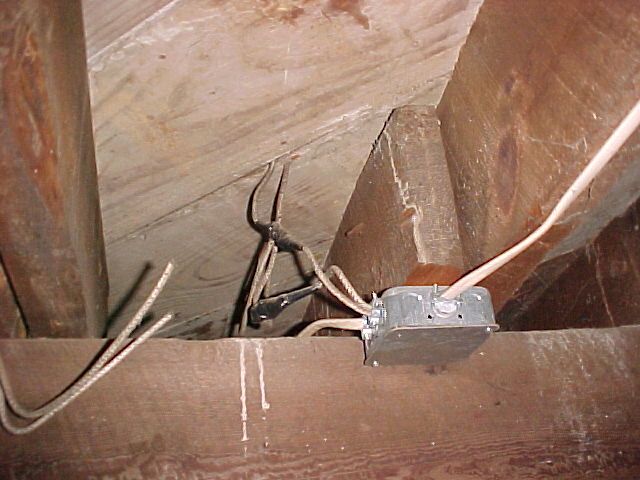 I received a bunch of simple "Yes" responses. But only one of you went a little deeper.... I received a bunch of simple "Yes" responses. But only one of you went a little deeper....
All wire connections should be placed in a junction box. The cut wires left dangling there goes without question - YES. What if someone somehow powers those two wires up? Inspect,evaluate, & direct in every report. Chris Burkhart - Sandy, Utah
I agree about the two dangling wires to the left side of the photo. The real condition that I wanted discusses was "What is the correct way to splice new Romex into old Knob & Tube?"
| This following graphic was scanned from the latest edition of the Electrical Code Check book ($16.95). It identifies two conditions that we encounter regularly when working on older homes. First is the wuestion of what is the appropriate splice of knob & tube to knob & tube. This type of splice does not appear to have to be made inside a junction box. |
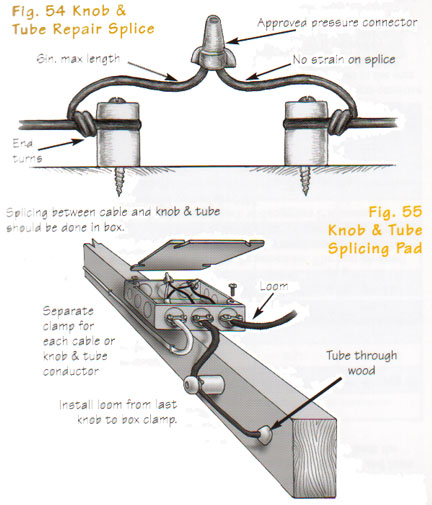 |
The second and most common condition that we find is the splicing of modern Romex to the older Knob & Tube. The Code Check image shows that the actual splice of the Knob & Tube should take place within the junction box. Now look back at last week's Photo Challenge. Where are the splices?
|
If you notice carefully at the Photo Challenge photo you will see that the Knob & Tube splicing takes place outside the box and then all of the Romex splices within the junction box. This is wrong, wrong, wrong!!! Yet we see this "Reportable Condition" quite often in older homes. I guess that we should at least give the guy a little credit in the photo because more often that not all of the splices are just made out in the thin air with no junction boxes at all. =:-)
Was this new information to you?
|
|
|
 PHOTO CHALLENGE #76 PHOTO CHALLENGE #76 |
What does this attic photo reveal? What would you report? What source would you use if you were called upon the carpet for reporting such a condition???
Please send your Photo Challenge pictures to PhotoChallenge@TheHomeInspector.com
|
|
|
 QUOTABLE QUOTE QUOTABLE QUOTE |
| "If it weren't for Edison we'd be watching TV by candlelight." Anonymous |
PLEASE NOTE: This is an actual edition of the Monday Morning Messenger. Subscription also entitles you to the last 6 years of back issues as well. CLICK HERE TO SUBSCRIBE
|